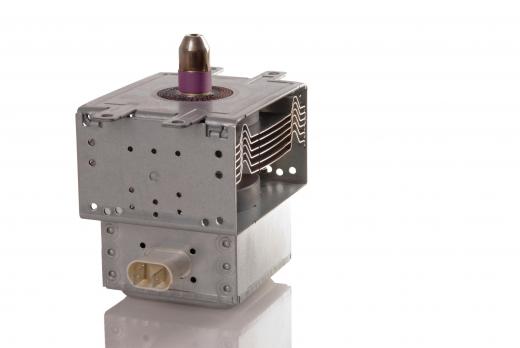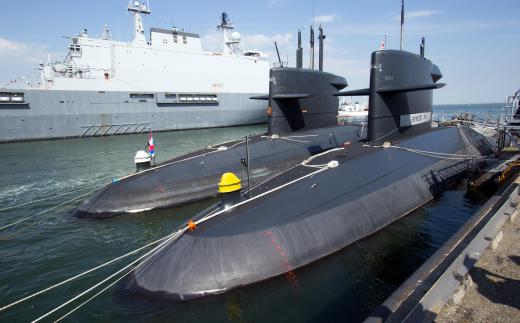What is a Magnetron?
A magnetron is a device that uses the interaction of a stream of electrons, guided by a magnetic field, with cavities within a block of copper to produce microwave radiation. The frequency range of the radiation depends on the size of the cavities. The devices are used in radar, and microwave ovens, where the radiation causes the molecules in food — particularly water molecules — to vibrate, leading to a rapid rise in temperature that is sufficient to cook the food.
How It Works

A magnetron consists of a short copper cylinder with a number of cavities that open into a central vacuum chamber containing a metal cathode. A permanent magnet provides a magnetic field that runs parallel to the axis of the cylinder. The cathode is heated by a high voltage direct current, causing it to produce electrons that stream out toward the cylinder wall, at right angles to the magnetic field. The electrons are deflected by the field into curved paths, causing them to set up circular currents within the cavities. These currents produce microwave radiation at frequencies that are related to the size of the cavities.

The microwaves must then be directed to where they are needed. This is achieved by a metal structure known as a waveguide, along which the waves travel. It normally extends outside the main body from one of the cavities, capturing the microwaves and guiding them along its length. In the case of a magnetron used for radar, the waveguide will connect to an antenna that transmits the waves. In a microwave oven, it will direct the waves into the oven chamber so that they can be used for cooking.
Uses
Magnetrons are used to generate microwaves for radar, as they can achieve the required power output. A drawback with a simple magnetron is that, although the range of frequencies produced is determined by the size of the cavities, there is variation within that range, due to fluctuations in the current, and changes in temperature. While this is not a problem when the energy produced is used for heating, it affects the accuracy of radar images. This can be overcome using adjustable conducting materials that can be inserted into the cavities to tune the radiation as required.
The most familiar use of magnetrons is in microwave ovens. These direct the waves into a small cooking chamber, where food can be cooked very rapidly. Some molecules in food are polar, which means that they have a positive charge at one side and a negative charge at the other. These molecules, when bombarded with electromagnetic radiation in the microwave range, align themselves to the alternating electric and magnetic fields produced by the waves, causing them to vibrate rapidly, which leads to fast heating. One such molecule is water, which is present in significant amounts in most foods.
History
In the 1920s, Albert Hull, an employee at a well-known electric company was researching vacuum tubes when he created the magnetron. Hull, however, could think of few uses for his invention, and it remained largely unused for some time. In the late 1930s and early 1940s, two engineers named Harry Boot and John Randall decided to explore the device further. Earlier versions had consisted of a cathode and anodes inside a glass tube, but Boot and Randall instead used copper, a good electrical conductor, to build a casing with cavities that also acted as an anode. This resulted in a device that was much more powerful, producing an output of 400 watts in a space smaller than four inches (10 cm).
As Boot and Randall developed stronger magnetron tubes, they discovered that these were ideal for radar. During World War II, United States submarines began using them, which allowed the radar equipment to detect enemy ships more quickly. In the late 1940s, Dr. Percy Spenser, an American engineer and inventor, further tested the output of magnetron tubes in his lab. He noted that the candy bar in his pocket had completely melted while he was working with the tubes. He decided to place a few kernels of popcorn near the machinery to see what would happen, and noticed that it made the kernels pop.
Dr. Spenser called for his assistant and the two men decided to place a whole egg near the device. When the egg exploded, Dr. Spenser realized he had discovered a fascinating form of cooking. Spenser went on to help create the world's first microwave oven in 1947. The initial model weighed over 700 pounds (318 kg), was more than five feet (1.5 meters) tall, and cost more than $5,000 US Dollars (USD).
AS FEATURED ON:
AS FEATURED ON:












Discussion Comments
I have some magnetrons that came out of a working microwave. I don't want to trash them. What should I do with them?
@anon87024: Sorry, but you can't physically change the magnetron frequency. Frequency adjustment is done by adjusting the vanes in the mgt diode prior to final sealing.
I think the scorch mark is more likely from someone overcooked something in the microwave. The walls/cavity itself should not be able to absorb microwaves.
I agree with anon76626. Please exercise a lot of caution when taking apart or salvaging parts from microwaves. They are insanely dangerous for a couple of reasons.
1. The transformers in them are not really current limited, so they are nasty little devils.
2. The magnetron itself is not really something you should be playing around with if you are a newbie. If you happen to break them, beryllium dust can get into the air which will make you die a very horrible death if you breathe it in.
I wouldn't mess around with microwaves unless you have some experience/knowledge in handling or salvaging high voltage electronics. I would start with crts or neon sign transformers first (again exercise caution with these). Good luck, and be safe.
The article states, “a magnetron is a tube that utilizes electrical and magnetic currents in order to create an intense heat output.” The purpose of a magnetron is to create RF waves not heat. The ‘heat’ in a microwave oven is caused by the RF energy exciting the water molecules in whatever is in the oven.
@anon85737: Care to back your conjecture up with a real statement or facts?
Can the frequency of a magnetron be altered? How?
this article while basically factually correct, is laced with human conjecture. Thanks.
I came across this website seeking info on some of my projects.
A word of caution for all people wanting info on microwaves, if you are just curious please look up all about them first before you start fooling around with them. They have deadly high voltage.
I have many projects using the TR from them also the mags. i have built welders with them and my current project is a microwave gun. i finally phase locked two of the mags after a lot of testing.
Again, do not attempt any projects with these microwaves unless you have many years of knowledge. A person would be lucky to get a second chance!
I have a Sharp microwave oven and everything works but it does not heat. Please give me the clues.
why can't a magnetron be used as an amplifier?
I just had my microwave repaired. It is a Kitchenaid above the range microwave. I replaced the magnetron,capacitor and a diode. It seems that the microwave does not cook as fast as it once did and in some cases the inside light flickers when it is heating. My question is,could the magnetron be of a lesser power than the one that originally came with the unit?
I have a Galaxy microwave oven and every thing works but it does not heat. What might be the problem?
My microwave oven, all the functions are normal but its heating is stopped. what may be the probable cause.
Can a magnetron be voltage controlled by an FM broadcast exciter/transmitter to amplify the signal of the transmitter?
And, can a magnetron be connected to an antenna to increase the range of the radio frequency output of the magnetron?
Can cutting into a magnetron tube to retrieve the copper have any ill effects?
In the early days of microwave ovens they could operate with the door open. Quite a nasty explosion when people tried drying their hair LOL
Timdives question:
Yes ground penetrating radar (GPR) can be used for this in non-salty water. Search for GPR and Unexploded Ordinance (UO).
My microwave just stopped working. Could it be the magnetron tube? The fuse, circuit breaker and outlet are all okay, but I get no power at all.
If you open a microwave oven while it is working it will shut off as a safety measure. Nonetheless, I had to repair some microwave ovens that would go on even if the door was open (the computer was malfunctioning).
I doubt a faulty magnetron would ruin the interior walls since they are designed to bounce the waves rather than absorbing their energy
The circular path taken by the electrons in the magnetron cavity is due to the Lorentz force that is establish because the electrons are moving radially through an axial magnetic field. Basically, the magnetic field isn't opposing the electron's travel... it's just making it circle the tube as it crosses the gap from cathode to anode. And that's what causes resonance in the side cavities.
How is magnetron important to the human aspect?
I been using microwaves since a loooong time now, my baby tells me today that it is correct to turn off the power knob first and then open the door. I believe when you do open the door while the micrrowave is working its shuts the power off as a safety feature. so I am curious, is it "OK" to open it while it is operating?? I have been doing it for ages now.....kindly help !!!!
Is a magnetron radar capable of detecting underwater explosives? if not what would be the tool to use without blowing up?
You don't mean SONAR. You mean RADAR. The magnetron is a microwave device.
Unlikely, since the interior of the oven is designed not to be adversely affected by the frequencies produced by the magnetron. More likely is that steam has degraded it, or possibly it could suffer damage if the oven was turned on with nothing in it to absorb the energy.
could a faulty magnetron in a microwave cause the interior of the oven to scorch?
Post your comments